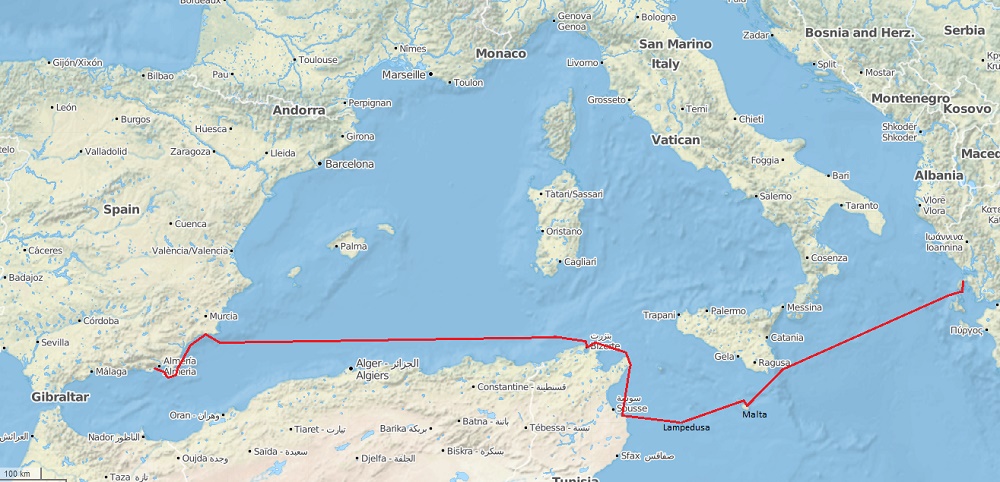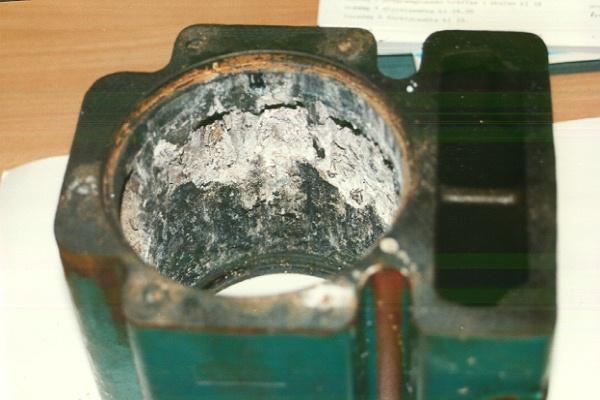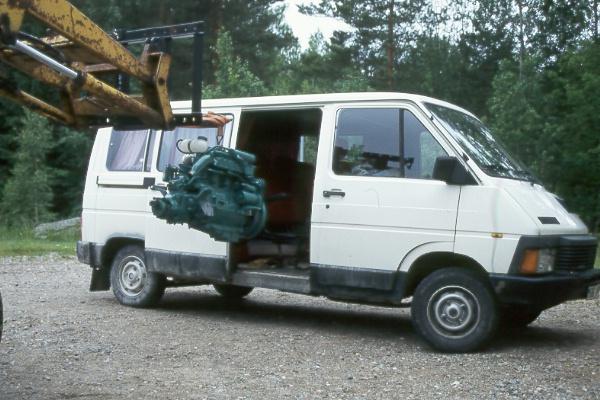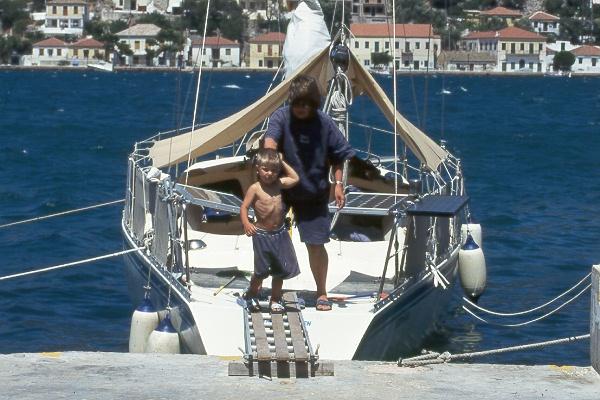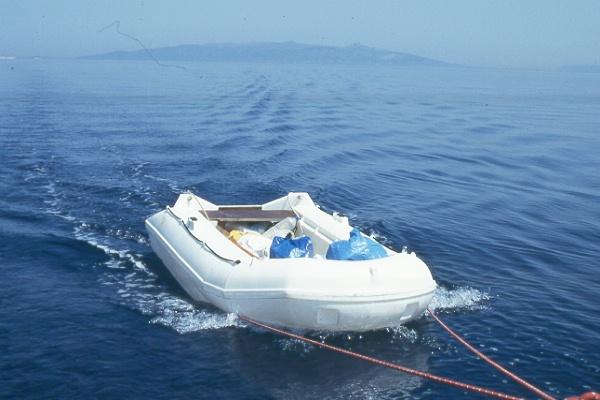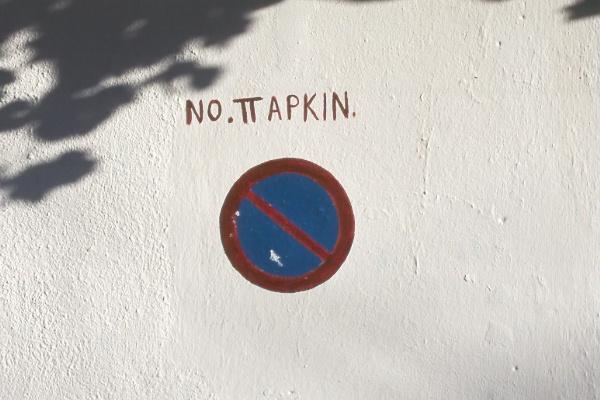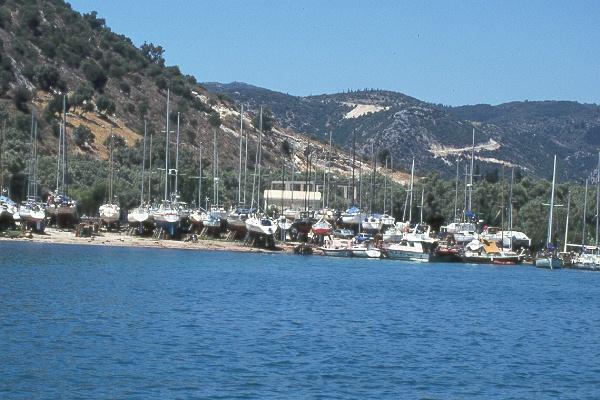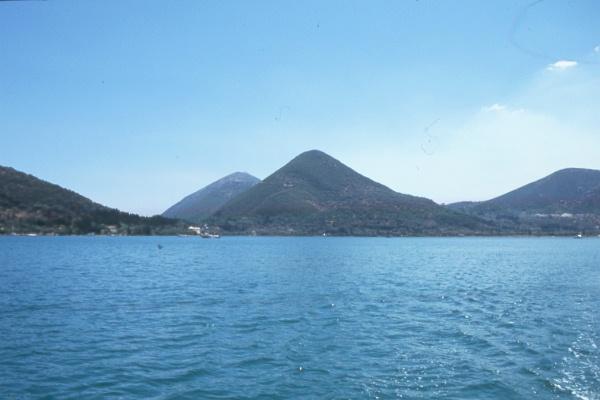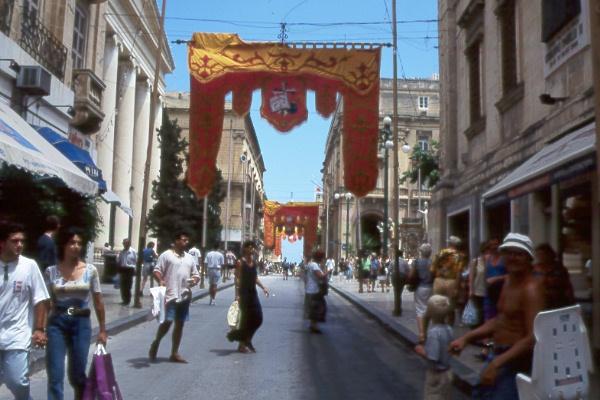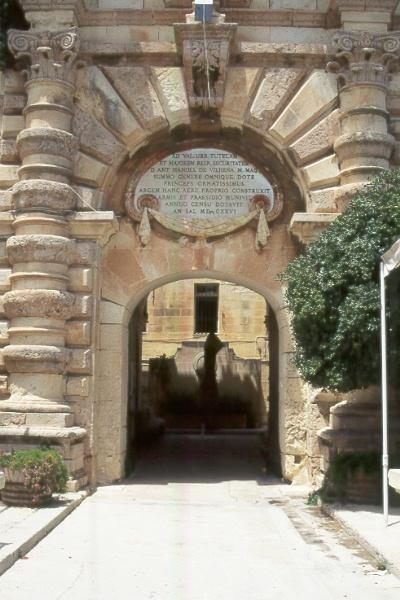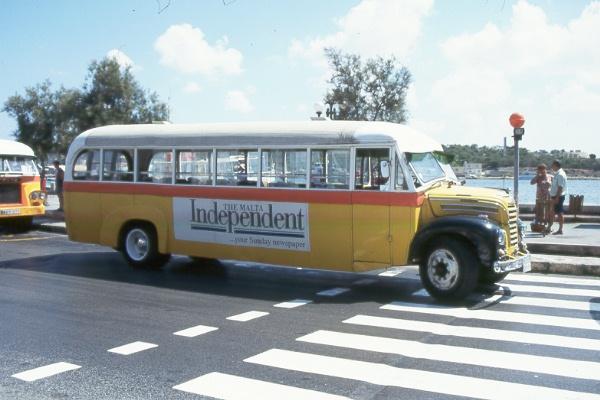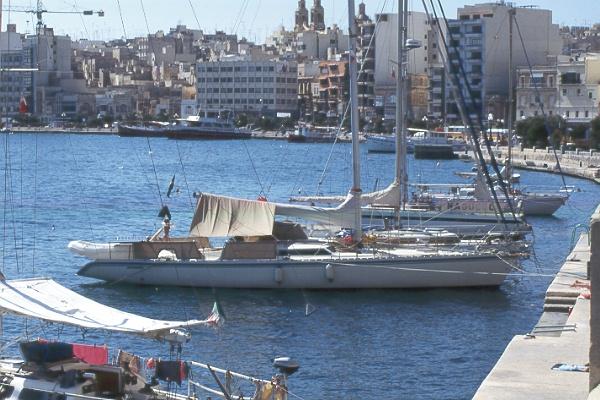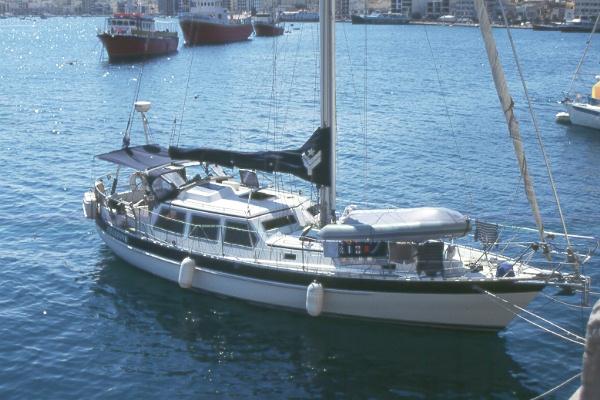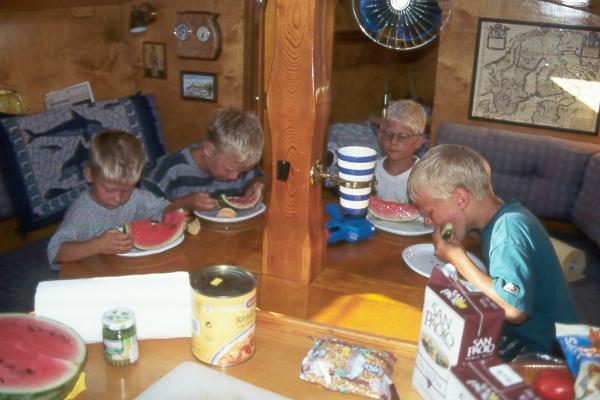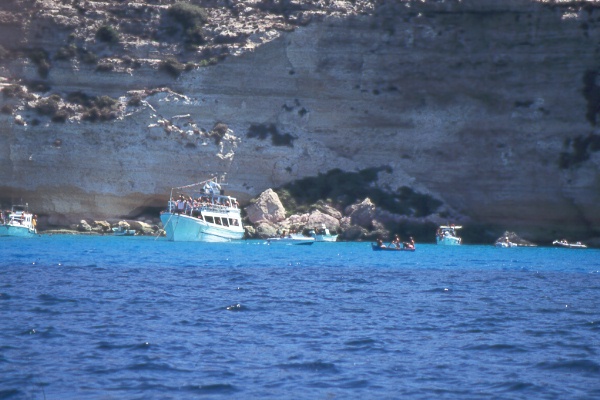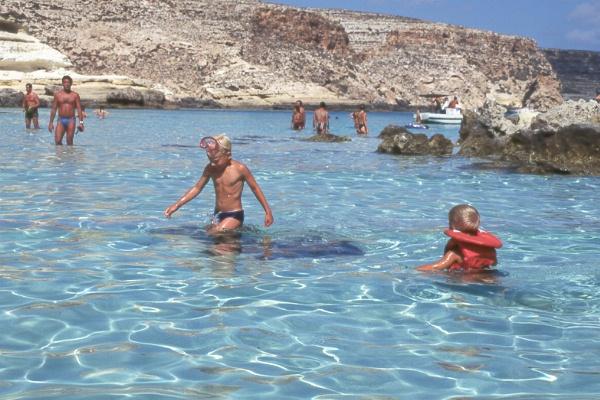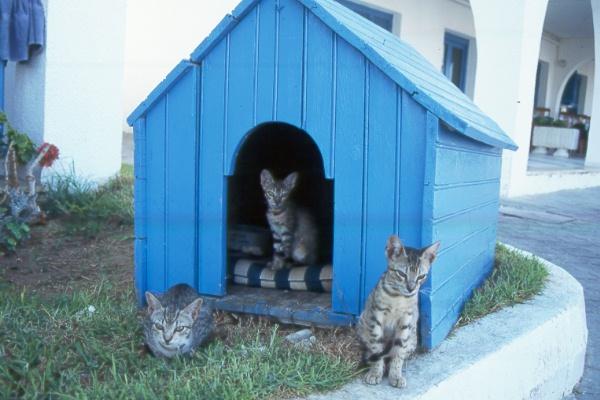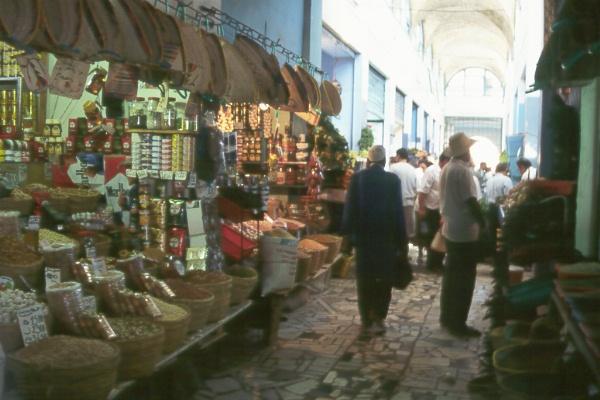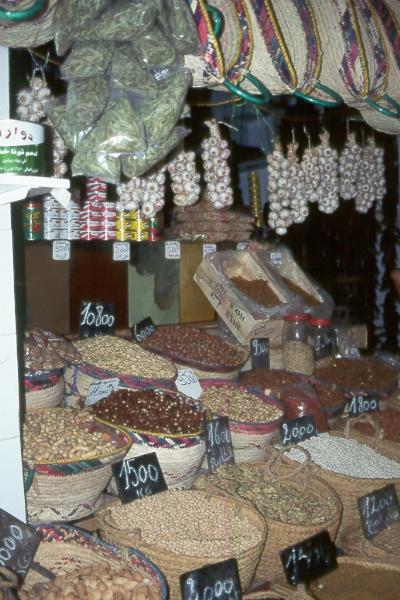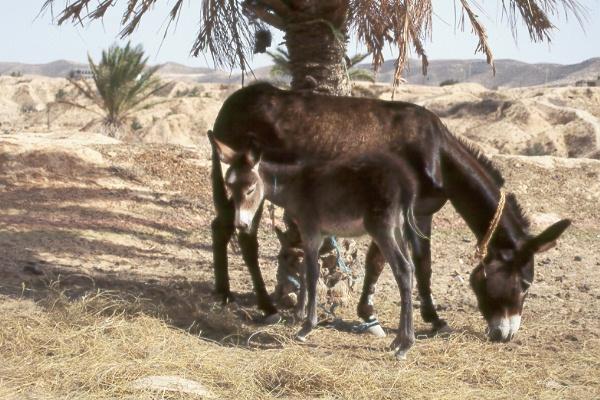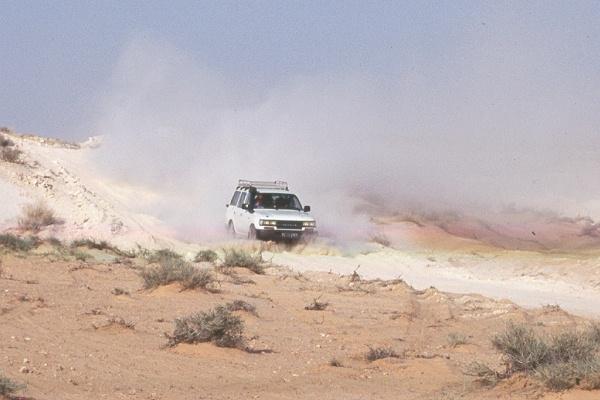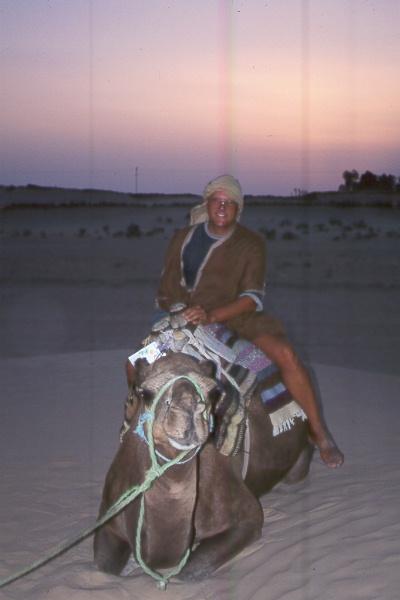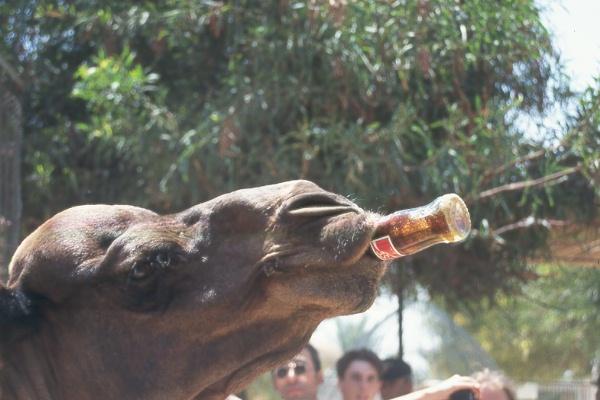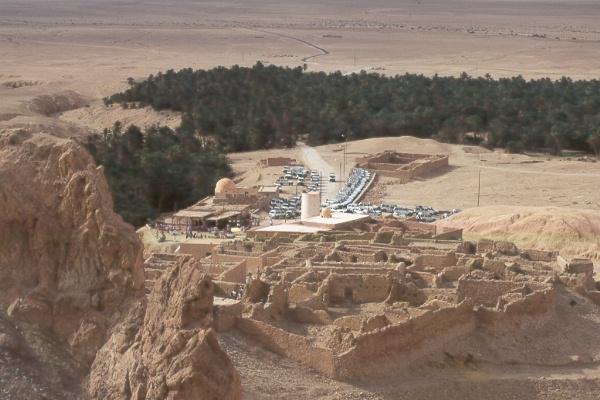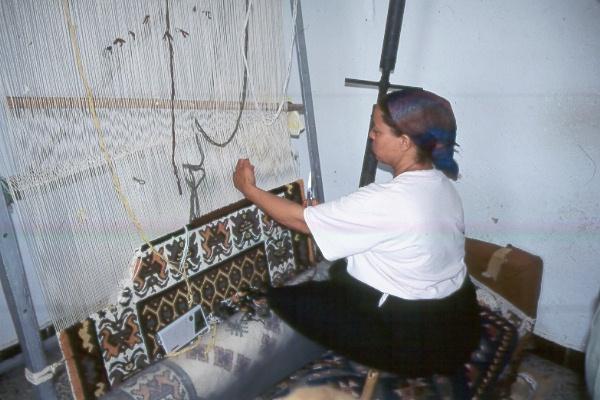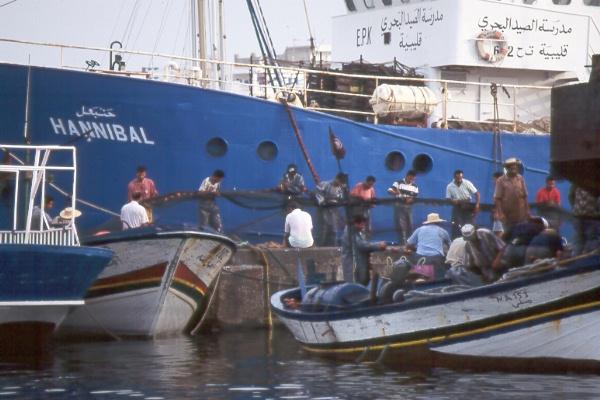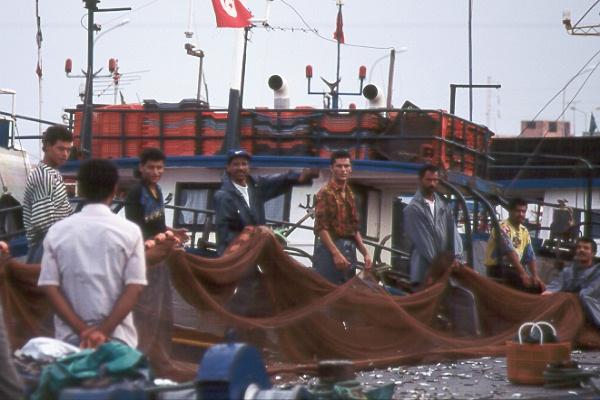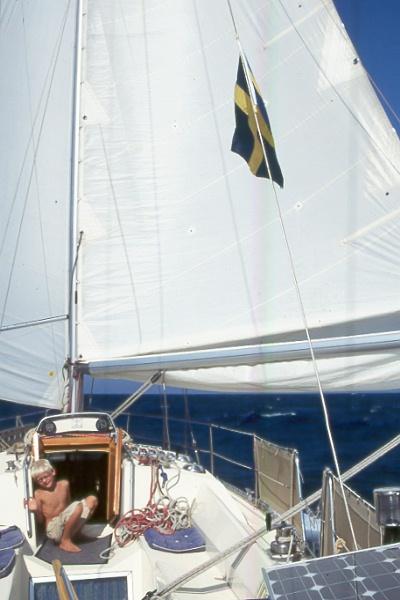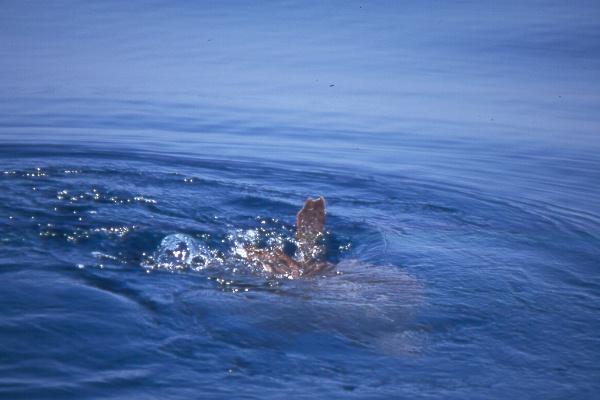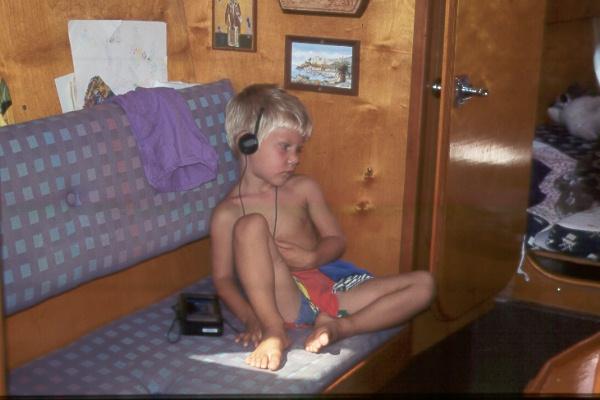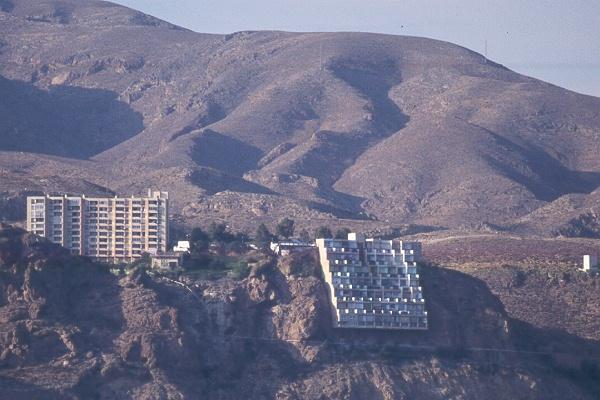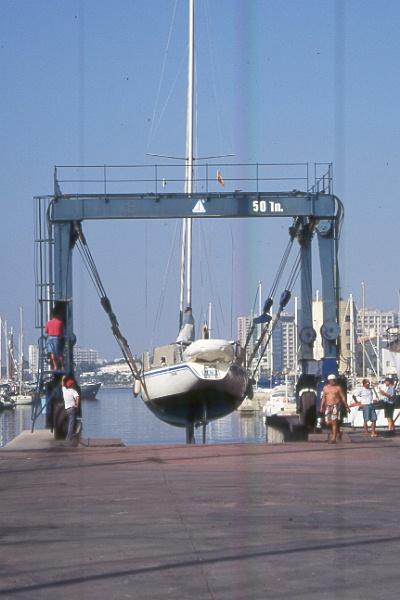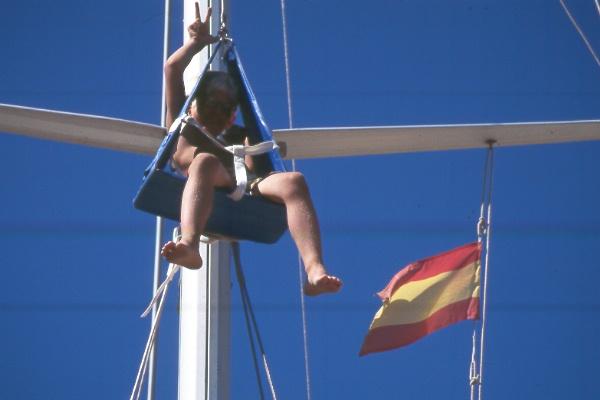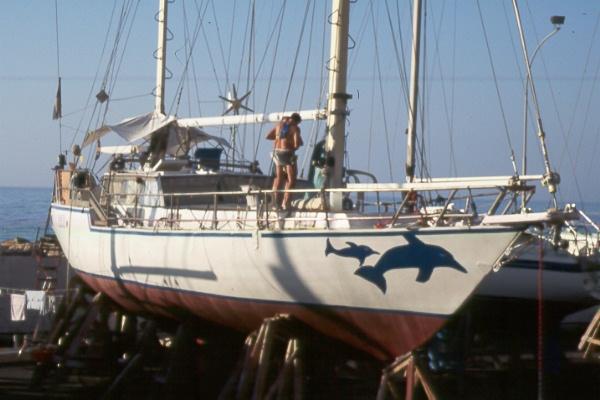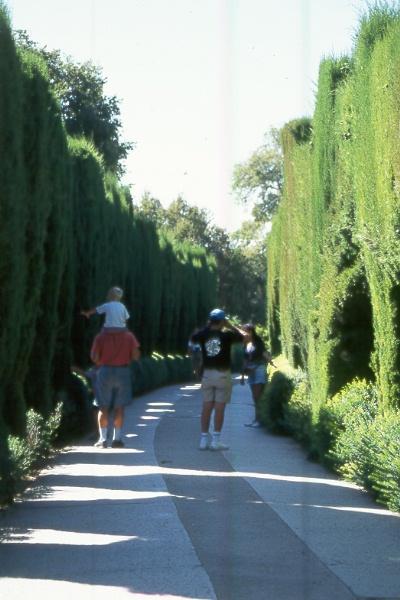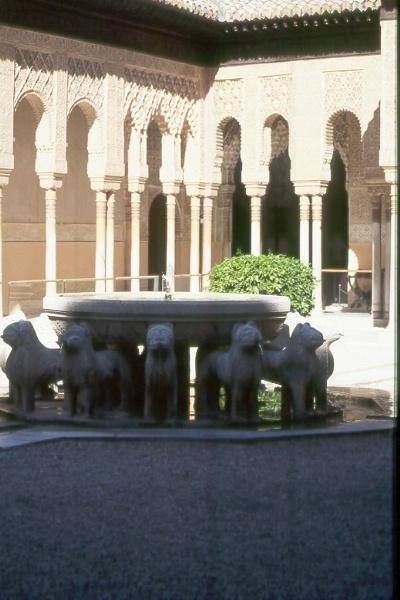
 1997
1997


Malta and Tunisia
Greece, Malta, Tunisia and Spain by Johan Kjellander 1997-2014 På svenska
Summer-97 started with mechanical work. During the winter in Sweden I had renovated Lynx´s engine and it was now time to put it in place again. After that we spent some weeks in the Ionian archipelago before we left Greece and set course to Malta. After Malta we visited Tunisia and then sailed on to Spain where we ended the season in Aguadulce after a total of 1300 NM.
Tove took the pictures and I wrote the texts.
Greece
Once again during the winter we had the boat at Kiriakos Vagenas shipyard in Vliho bay, Lefkas. This winter without engine though. Last year ended with serious engine problems so when we returned to Sweden we took the motor with us in our van.
During the winter I tore the engine apart and found that the cooling channels in the cylinders were completely clogged. To clear the channels on a Volvo VP MD-17 you have to press out the cylinder linings and it was easier said than done. Hydraulic press, 15 tons of pressure and a large gas burner, then it said bang and the lining released. The picture shows how it looked inside. A white lime coating, hard as stone fills up the cooling channels completely. Not very much rust though!
After many hours and a terrible amount of money, we had virtually a new engine, even better. Just before mid-summer, we loaded the bus and headed south. The engine was placed on the floor between the seats.
It usually takes 5-6 days for us to drive to Greece with our bus. We then immediately mounted our newly renovated engine and launched the boat. It was quite nervous, there is a lot that can go wrong after such a major repair job. The gods, however, were with us and the engine started and spun like a cat. Since then, it has worked perfectly.
We test sailed a couple of weeks and with us on board was cousin Jonas with family who came down to take our bus back to Sweden. In the picture we are moored in the port of Vathi on Ithaka. Note the gangway that we made of an aluminum ladder and 3 pressure-impregnated thin boards. When you are moored in this way you cannot come too close to the quay. The smallest swell from a passing motorboat would make you hit the quay and damage the boat. Without a gangway, it would therefore be difficult to get ashore and if you are 8 people, of which 4 are children, it saves a lot on your nerves with a decent gangway.
A few days later we were on a small beach in a lovely bay on Meganisi. Our guests from Sweden thought the beach looked untidy, which it did very much. We ourselves were used to all sorts of garbage on the beaches so we didn't think so much about it. Having said that why not do something about it! The entire beach was cleaned and all debris was packed in plastic bags and deposited in our dinghy. We towed the dinghy to Astakos in the evening where the ladies went ashore and put all the garbage in the trash bins along the promenade. People looked at us. They probably wondered how long we had been at sea having so much garbage with us!
High up on a cliff on Meganisi lies the small village of Spartakhori. Old-fashioned and charming. How about the sign for example?
English text but Greek letters. You can probably guess what it means.
Our guests returned to Sweden and we started to prepare to leave Greece for good. A final picture of our shipyard where we met so many wonderful people and where Lynx had stayed two winters. It was sad to say goodbye but you can't stay forever if yoy want to see more.
Bye bye, Maria, Takis and Pandora.
When you steer out of Vliho bay where the boat yard is, you have this wonderful sight right in your back. We called it the sugar top, just like the mountain in Rio.
Malta
After nice sailing first west towards Sicily and then south towards Malta, after 350 nautical miles we entered the port of Valetta. Malta does not belong to the EU, so we had to clear customs the old way. We were assigned a berth in Sliema just next door. Sliema is actually a city of its own but very close with Valetta.
We took our bikes ashore and explored the city for a few days. The picture shows the main street in Valetta.
One of our bike tours took us up to the old, prestigious Valetta Yacht Club, housed in what can almost be considered a palace. Quite different from the barracks that houses our own club at home in Hjälmaren. We were shown into the bar to sign the guest book and have a drink of course. The picture shows the entrance to the boat club.
Malta is an old English colony but nowadays independent. The language is English and many retired English people have settled here to enjoy the autumn of life in the warm climate. The proximity to Africa is also evident.
A funny part of the streetlife are the old buses that continue to run year after year. We didn't see a single new bus!
It was warm and nice and a sun cover is a must. The kids had a great time in the water. Here we are tied up in our berth in Sliema.
One day a Finnish-Swedish boat on the way home from sailing around the world showed up. The skippers name was Johan, just like me and in addition they had two boys of the same age as ours. A lot of joy on both boats. Meeting friends who also speak Swedish is a highlight for the children when they have been away from home so long!
The name of the boat was Filifjonk and it was built in the USA.
Here are four young scandinavians, all with white hair, feasting on watermelon. Martin with glasses, Gustav far to the left, Emil to the far right and Linus between Martin and Gustav. It's fun to study kids who have sailed as much as these. They adapt so incredibly easy to the boating life and play together so nicely sometimes in one boat and sometimes in the other. For hours, they can then play on the quay with a break for a swim in the warm water. Can you imagine a better life. It seems like the little uncomplicated world that a boat constitutes with its relatively fixed rules is a safe and good life for a 6 year old.
Tunisia
From Malta is close to Africa. We decided that the next stop would be Monastir in Tunisia but on the way there is an island called Lampedusa and here we stopped for an overnight stay. It turned out to be a forgotten island that belongs to Italy but which is now becoming a popular tourist destination. Why, you can easily understand. On the south side of the island there is a bay with the most amazing white sand you can imagine. A real bath paradise.
The picture clearly shows where the white bottom begins. This is where the dark blue color turns into light blue. The the bottom reflects the sunlight and makes the water light blue. The water was incredibly clear. There was no problem whatsoever to see details at 20 meters depth. A funny effect of the white bottom was that the boats in the bay seemed to be lit up from below. As we approached from the sea, it first appeared that there were a number of light blue boats in the bay. I remember telling Tove that there must be a fleet from a rental company or something because all the boats were the same unusual color. When we got closer we saw that they were white but illuminated from below with blue light. One can imagine the phenomenon in the picture but it was much clearer in reality.
Wonderful beach on the south side of Lampedusa, close to Africa.
A few days later we spotted the lights from Monastir. According to the chart, it was a tricky approach so we waited a few hours out at sea for the sun to come up before we entered the harbour. Once inside, we were received in the best way possible. We got a good berth in the marina with both electricity and water, something we had not been spoiled with in Greece.
It was obvious that we were in Africa, even the cats looked different with their big ears. They lived in the little blue house down in the harbor and walked around on the pontoons now and then to see if any there was anything to eat. We had a special cat that often came to us. The kids named it Miss Monastir. We still talk about it now and then.
Going to the market is always fun. Each country has its character. In the fish department they sold small sharks. Approximately 20-30 cm long. One had to point out which one you wanted and then the fishmonger flew them and put them in a paper. The price was low and the taste was good.
A lot of dry goods, beans and groats that we had never seen before.
We wanted to make a trip inland and decided on a three-day safari with Landrover and guide down to the Sahara in the south of Tunisia. On the way down we passed Matmata, the desert-like area where the Berbes live and where the Star Wars film was recorded once. The Berbes are an indigenous people who still live under rather primitive conditions in burrows which they dig into the sandy rock. They have animals like donkeys, but where they get food for the animals I do not understand. Not much grows in these mountains.
Desert safari with Landrover is a large industry in Tunisia. We stopped for a short break and soon the next Landrover came and passed us at full speed. The drivers were mostly young men who thought it was fun to drive fast in the sand dunes. It was quite bumpy so you had to hold on.
If you are a tourist then you are. Of course we would ride on camels and of course we would dress up like bedouins at extra cost. In fact, we barely had any choice. Our guide was very careful that we would act as real tourists and benefit the local organizers. Of course we didn't mind it and it wasn't expensive but it felt a bit silly. The kids of course, thought it was great fun.
We made a trip of just over an hour at sunset and it was definitely a very special experience to sit on the back of a camel in the beautiful light and only see sand dunes as far as the eye reached. It looked like an ocean where the waves suddenly solidified and turned into sand.
Unfortunately, there are dark stripes on the picture. We don't know where they come from.
This camel is world famous in Tunisia. He is at a zoo in Tozeur and when the caretaker puts a bottle of Coca-Cola on the ground in front of him, the camel bends down, grabs the bottle with his mouth and lifts it high up in the air so that he can swallow the liquid. Then he neatly puts the empty bottle down on the ground again. Great!
We passed many oases. The one in the picture is called Chebika. Growing figs seems to be the most important industry. It was terribly hot, over 40 degrees and without air conditioning in the Landrover it soon became almost unbearable. I asked the driver why he didn't have air conditioning in the car but he answerd to my surprise that he had, but nobody had asked him to turn it on. He obviously did not think it was hot! Maybe you get used to it after a few hundred years.
On the way back to Monastir we passed Kairouan which is famous for its carpets. Here we were once again exposed to pressure from our guide (he had good commission) and it all ended with us buying a beautiful blue handmade rug that now adorns its place in our living room.
The carpet factory was run as a sort of collective where the families worked at home and took their products to a special sales venue with people who were talented sales people. Revenue was then shared between everyone involved. Fantastic carpets but many were very expensive. Most expensive were the hand-knotted with the thinnest thread. The cheapest were embroidered. The one we bought was embroidered, about 1.5 X 2.5 meters in size and cost about 4,500 SEK (450 USD) The kids were presented with small table mats as a bonus. I guess the salesman was happy when we left, I don't think we mastered the negotiation about the price particularly well. He was much better.
It was time to leave Monastir and we sailed north along the coast and visited a few small fishing ports on our way. There was really no place for sailboats here so you had to get along with the local people as good as possible. Fishing was conducted in all forms with large boats and small. Hannibal was a leader from Cartago 2000 years ago but here a boat was named after him.
On the picture to the right you see a group of fishermen shaking out small fish from a net. What kind of fish, I have unfortunately forgotten.
Spain
Our visit to Tunisia ended in Bizert which has a nice marina. From there we would sail directly to Spain, 600 miles. According to the books, one should be able to expect a fairly steady easterly wind most of the time and even if it did not blow to begin with it would come later. We sailed downwind for several days. During daylight the wind increased slightly and the speed was good, occasionally over 12 knots in a surf but usually 6-8 knots. During the dark hours speed was slower.
What strange animal is this waving at us? Well, a turtle. There were plenty of them along the coast of Africa.
At night, the wind decreased and speed went down. The daily distances were around 125 nautical miles. We navigated using dead reckoning keeping an easterly route about 50 miles out from the coast. However, we checked our position with the sextant a couple of times. You do not want to end up in Algeria. After a few days, there was some difference between the dead reckoning and the positions we got by the sextant and then you have to decide which one to trust. We chose the sextant, and it turned out right. On the fifth day, we spotted Cartagena just as we wanted! In retrospect, we have found that the reason why the dead reckoning was wrong was an old chart with an indication of magnetic variation and its rate of change that did not match reality at all. New charts are expensive but can be so important!
It was a long and not very exiting voyage from Tunisia to Spain. Sometimes when it gets boring you just have to find something to do. Why not listen to Emil in Lönneberga for example?
After a couple of days in Cartagena, we followed the coast south towards the Costa del Sol. Here the hotels were close to the shore. Some even hanging out over the cliffs.
Well, in the end we found a good place for the boat to spend the winter in Acuadulce. Nice marina with travellift and all facilities. Reasonable price and nice people. The watch dog was called Golfo and the kids soon learned that he did bark a lot, but it was mainly because he was scared. As a playmate, he was top and he loved to throw himself in the water and save whatever the children threw there.
After a few days, we hauled Lynx out and started the preparations to leave her for the winter
It takes a while to close down the boat. Maybe a week or so. Meanwhile, you learn to know the place and socialize with people. The kids play among the boats and get new friends. When it gets boring you have to find something exciting to do. Going up the mast is fun!
A good friend we got in Tauno. He was a retired school teacher from northern Finland and had built a Roberts 53 in wood and polyester/fiberglass himself in just 3 years! An amazing man. He came to us in the mornings with freshly baked bread and offered to be a babysitter when we needed. He had 3 (three) television sets on board !!
I had long nurtured the dream of building a new boat but when I met Tauno I knew I had to. Persuading Tove was no problem. We both thought we had made the Mediterranean and the boat was now crowded with two growing kids. The oldest son has started school and next year it is time for the little one. It should be good to be home for a few years and build a new boat so that they can attend to school in good order.
Next year we will take Lynx back to Sweden and there we will sell her and start building a new boat.
To end of the season we rented a car and went 10 miles up the mountains to the see mthe palace of Alhambra. Beautiful house and beautiful garden.
The lion garden on the right is famous for its beauty. The Alhambra is a castle area in the city of Granada surrounded by towered walls. Here you will find the Alcazaba, a Moorish fortress from the 13th century. The Arabs lived here when they ruled over Spain and the area is still considered the best preserved Arab building in Europe. The Arabs were expelled in 1492 (the same year that Columbus rediscovered America) and then the Spanish rulers lived here for hundreds of years.
Traveling is wonderful and you learn a lot and get great perspectives which is useful. Sweden in all honor but it is a very small part of the world.
One day later we were home again and now the planning for next years long sailing back home via the Azores began!
